If you believe the internet, balcony or mini plug-in solar panel system sales are booming across Europe, yet there isn’t more than a whisper about them in Australia. Given the obstacles thrown at renters and apartment dwellers denying them entry to the solar revolution, should these systems be available here, too? Let’s find out.
What Is A Balcony Solar Panel System?
Firstly, to dispel any myths, a balcony solar panel system is NOT the same as a portable camping solar panel system!
- A portable camping solar panel system typically comprises lightweight, foldable panels and a compact battery designed to provide off-grid power for small electronic devices and lighting while camping or travelling.
- A balcony solar panel system, or mini plug-in solar panel system, is connected to the grid. It integrates solar panels into balconies or terraces, feeding surplus electricity directly into a power outlet to offset energy consumption within the household or building.
That’s right, plug it into your powerpoint and to hell with all these regulatory headaches! No permission needed, no paperwork, no expensive electrician required, no worries, and here in Australia… NO WAY!
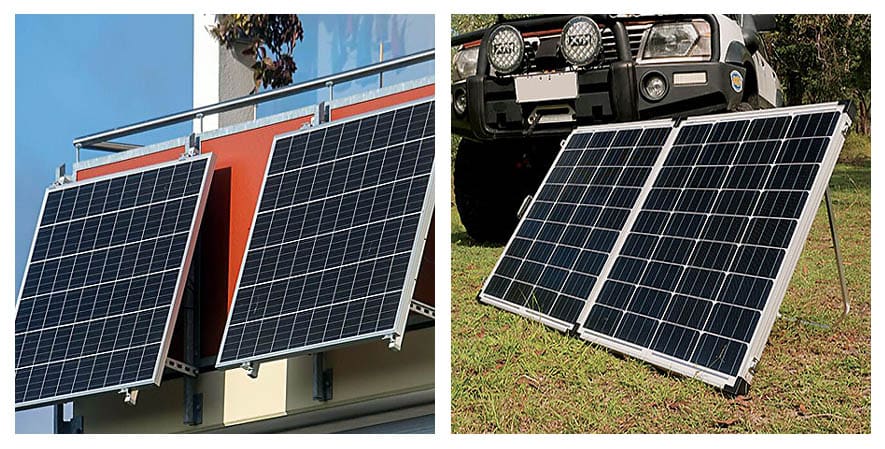
Left: Balcony solar panel system in Deutschland. Right: Camping solar panel system in Australia. They’re not the same thing!
Nanny State Or Necessary Regulation?
Hang on, back up a minute. Although these systems still need to be approved for use in Australia, they ARE regulated in other countries. So any freedom fighters complaining about Australia being the nanny state might need to get the facts straight before bemoaning their first-world problems.
The European standard is a maximum power of 800 W for balcony solar panel systems. The regulatory body in Germany, VDE (Verband der Elektrotechnik), has recently raised its limit from 600 W to 800 W along with a fleet of other proposals to encourage the use of these systems.
VDE CEO Ansgar Hinz: “The basis for the electrical safety of the systems is the VDE set of regulations. With the proposals for simplification, we want to help ensure that the use of mini power generation systems can become widespread in the future without compromising on safety.”
Systems must be registered by owners, any changes reported, and deregistered appropriately. Manufacturers must demonstrate potential risks associated with their use, include a description of safe assembly and commissioning, and guarantee their safety. Consumers may now use these solar panel systems on any meter, even allowing legacy spinning-disc type meters to run backwards “within the de minimis limit.”
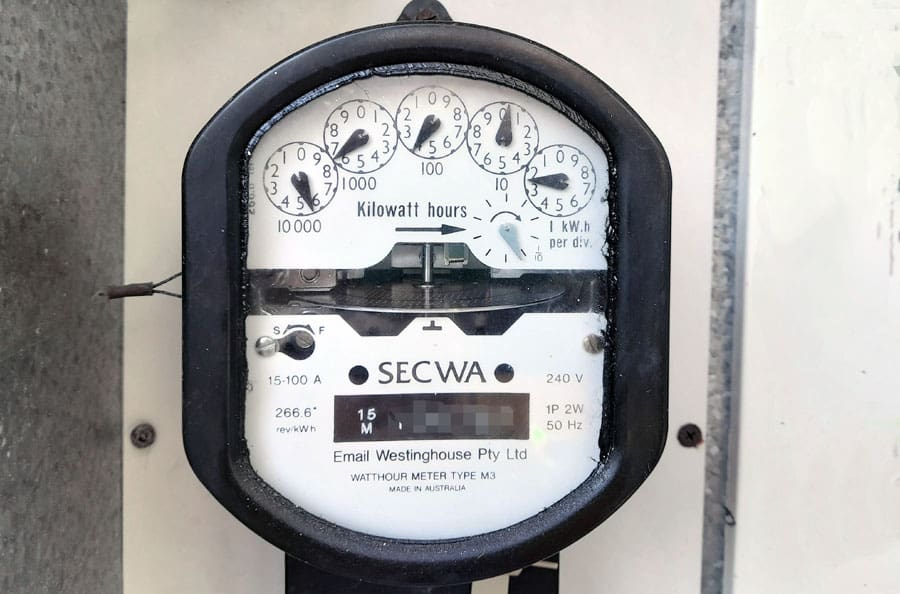
Wouldn’t it be nice to see one of these bad boys spinning backwards!
Backfeeding Safety Issues
We keep hearing about safety issues but don’t all electrical appliances have safety issues? Yes, however, even though these solar power plants are relatively small, back-feeding electricity into an electrical system creates several concerns.
Anti-islanding protection
The first one that comes to mind is something that most rooftop solar owners already know about. Anti-islanding is a built-in safety feature on grid-connected inverters that shuts down the solar output during a grid blackout. This safety precaution prevents energy from being exported to the grid and electrocuting line workers.
Overload protection
A standard rooftop solar system feeds energy into the homeowner’s switchboard on the grid supply side of the circuit breakers that protect the final sub-circuits (house load circuits.) Therefore, each protective device (circuit breaker) “sees” the full load current, whether or not it is supplied by the grid or your solar panels. It can then operate as designed and trip in an overload event.
With a balcony solar panel system, the energy is back-fed via a power point in one of those sub-circuits. This effectively increases the capacity of the circuit; however, the protective circuit breaker on the grid supply only “sees” the portion of the current flowing from the grid to meet the needs of the load. The additional capacity in the circuit means the cable is not adequately protected in an overload event.
I’m not sure what our European cousins are doing about this, if you can enlighten me, please leave a comment.
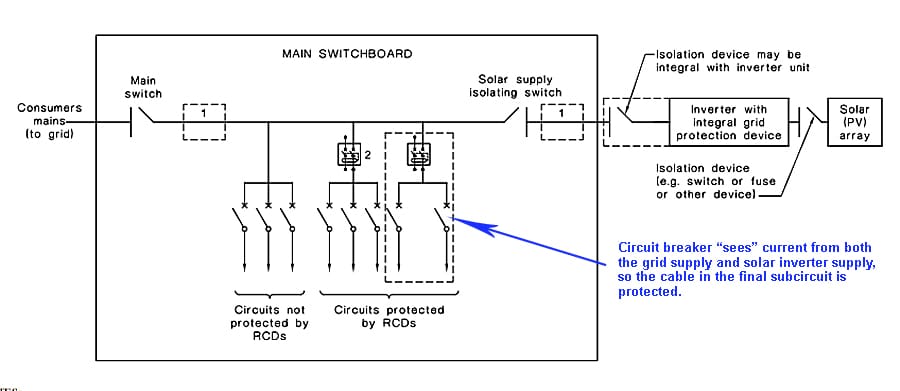
Line diagram of the circuit protection arrangement with grid supply and solar supply from a rooftop solar system.
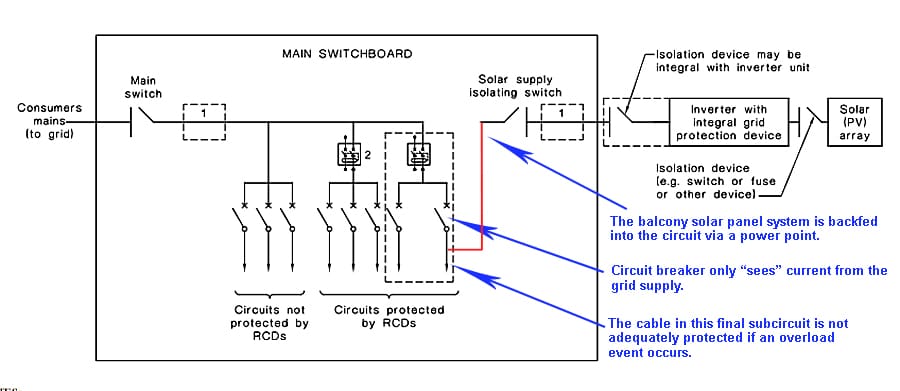
Line diagram of the circuit protection arrangement with grid supply and solar supply from a balcony solar panel system.
Correct RCD type
In most instances, Australian standards don’t require an RCD (residual current device) or RCBO (residual current breaker with overcurrent) to be installed with solar inverters unless specified by the manufacturer. However, if a balcony solar panel system gets plugged into a power circuit, an RCD or RCBO will be present. No problem, but…
The existing RCD will likely be the wrong type (type AC), which was common before an amendment of Australian Standard AS:3000 made in 2023. Inverter manufacturers typically specify at least type A, which is designed to trip on both sinusoidal AC waveforms and residual pulsating DC, which may be present if a fault condition is present.
I Fought The Law (And The Law Won)
Something readers may or may not care about is complying with the law! All electrical equipment sold in Australia, including solar inverters, must have an RCM (Registered Compliance Mark) and adhere to relevant Australian standards. Good luck with your insurance claim if the assessors see a discrepancy as they sift through the charred remains of your apartment. Sorry, freedom fighters, ignorance is no defence.
I realise that a percentage of the population loves to stick it to the man and revel at the thought of plugging in one of these systems or rigging up their own homegrown solar devices precariously connected to the grid. The solar guerrilla movement is undoubtedly alive in Australia, taking advantage of the many dirt-cheap legacy used solar inverters available. Tread carefully, friends. You might be out of your depth.
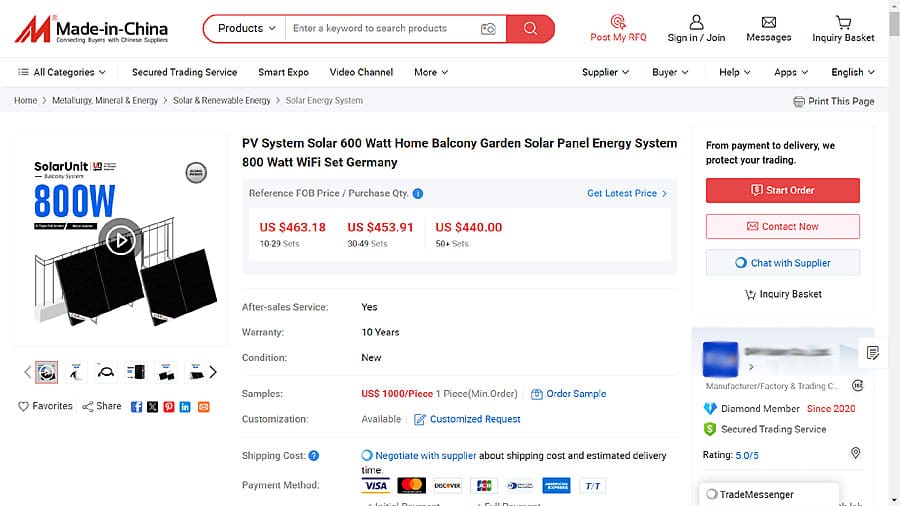
Would you take a chance on one of these? Go on, click the buy button. I dare you.
And Another Thing Or Two
And another thing: Is there a market for these balcony solar panel systems in Australia? Our most recent census puts only 10% of the population living in apartments compared to an average of 46% in Europe. The breakdown of renters, however, is similar in Australia and Europe, at about 30% of the population. Who knows, there may be potential Australian distributors quietly trying to get these things over the line.
And then there’s the elephant in the room. Hanging a few solar panels vertically off the side of a balcony is hardly the optimal position to get a return on investment for the system. Estimates quoted on the internet vary significantly, and it’s no surprise. I doubt if many apartment dwellers would be able to mount their panels in a position to take advantage of the full sun hours in a day.
Wrapping It Up
The tantalising prospect of balcony solar panel systems for apartment residents comes with a barrage of regulatory and safety hoops. While sidestepping bureaucratic red tape may seem tempting, staying within safety standards is a must. Plus, the practicality of squeezing meaningful energy yields is questionable. For now, you may be better off sticking with a portable camping solar panel system for emergencies, with the added bonus of power on camping trips!

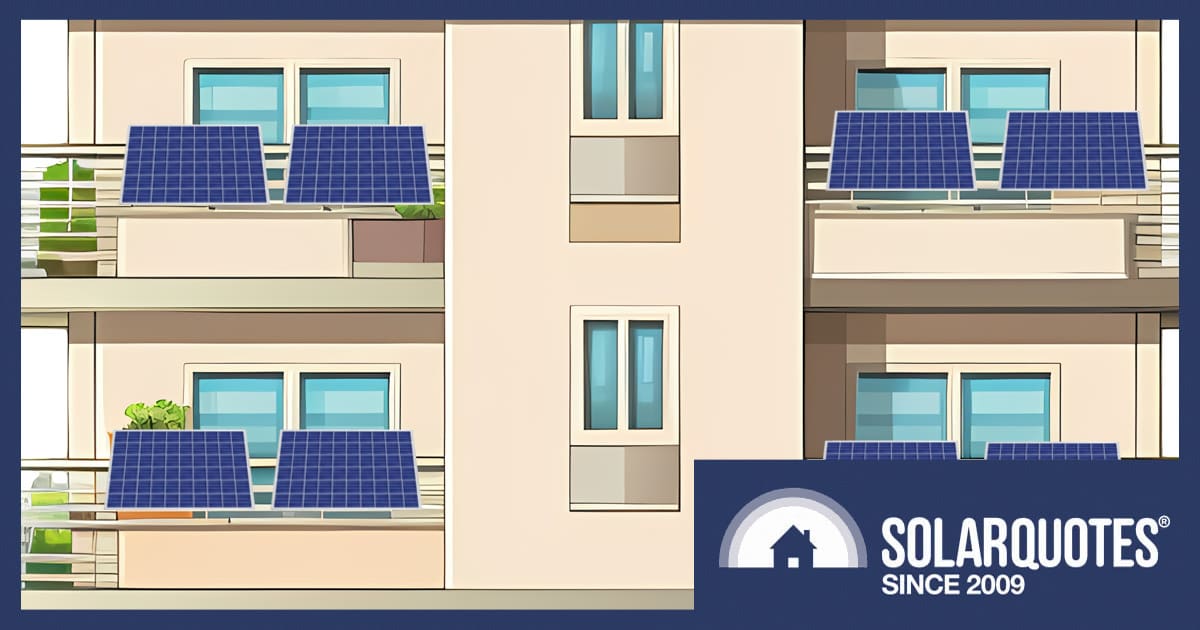
 RSS - Posts
RSS - Posts



Excellent article Kim. You’ve explained the technical problems with “plug-in” backfeed inverters very clearly. I’ll be sure to point people to this article.
Thank you Glen.
Just imagine a sky full of solar panels in a big wind event or storm?
The mind bogles – some could still be attached to railing !
Fascinating concept. Excellent point about the lack of proper protection on the circuit that the solar panel is plugged into. Umm, am I the only one concerned about the fact that there must be a live male plug attached to the end of those solar panels in order to plug it into a power point???
Hi Geoff. Yes it’s theoretically possible for the male plug to be live before being plugged in, but hardly likely, because the inverter is a grid following device that needs the grid to be present in order to synchronize and power up.
Anti island built into micro GPO connected inverters prevent the male plug becoming energised until plugged in and switched on at wall.
Actually no – the plug would not be live if the inverter has an anti-islanding circuit. This only connects the inverter output to the grid if the grid is detected. No grid – no output.
But it must have this feature.
Plus getting your body corporate to agree would be impossible. Many won’t even allow you to hang a towel on the railing. What about a scheme for unit owners to buy a fraction of a solar farm and use the income from this to offset their power bills?
That’s what I need! Could I hang them on my large North facing wall? I have solar panels on the roof, but they are not quite enough for airconditioning and heating. Find me someone who would do it for me!
In high latitudes, 90 degree vertical facing the equator is the optimal orientation for winter. Edmonton’s NAIT researched that, and whether it’s worth clearing snow off pamels.
Hanging panels om a south facimg wall would be ideal here, because electricity is so expensive here in winter, and apartment owners can’t use the roof.
And while some have air conditioners, others plant shade trees and use their basements if they’re home in daytime on hot days in midsummer.
I’m in a ground floor north facing apartment. Sun on the walls all year round particularly in winter. It would be great to be able to harness some solar energy. Why don’t new apartments have solar panels for their north facing balcony walls! It would be an improvement on clear glass!
Yes, hanging panels off a balcony would be frowned upon by most Landlords and apartment owners, however I can see guerilla solar and storage gaining traction in Australia.
And back-feeding into the grid here via a suicide cable is verboten. In Germany they require a special device/cable to do so.
However, we do have a lot of stand alone rental properties where this could work. Just need some solar access.
I am part of a Portable Power Station Facebook group with over 6000 members at last count. Most use them for camping setups but many also use them for powering at least a portion of their homes with a changeover switch at the meter box or via extension cables to appliances.
I have gone with the latter. Our hybrid system now means we are mostly off grid yet still able to export from our old grid connect system.
So how do pay for using the gris infrastructure.its not free it has yo be maintained.
I have been using this type of system for about 5 years. If you read the instructions and follow manufacturers installation requirements there is no issues. Less of the scare mongering please
Alan should we ask where you are using one of these systems?
I have been using this type of system for about 5 years. If you read the instructions and follow manufacturers installation requirements there is no issues. Less of the scare mongering please.
I have also saved a small fortune in the process
Not that I intend to buy one as I am happy with my solution, but I am interested in how this setup works. Can you share the name/maker of the product?
If it is connected to the grid and needs a signal, I assume it is no good during outages?
Are you in Australia?
Not scaremongering Alan. It’s called education. Not everyone has the wisdom of your good self, speaking of which, can you please share with our readers how you have dealt with the back feeding safety issues raised in the article?
I have a dedicated outdoor socket on its own spur which I is being utilized for the purpose of the system only, as per manafacuters instructions
Alan, that almost makes sense. If an overload occurs the portion of the circuit within the spur no problem – the cable is protected. However if an overload occurs upstream from, or outside the spur, the cable feeding the offending high current draw appliance will cop current flowing from all available generators and isn’t protected in a worst case scenario. I’m sure you’re aware of that, but is the average Joe? Do they even know which power points are on the same circuit? Unless the circuit is micro managed it almost makes any other power points or loads in that circuit outside the spur redundant. Alternatively you could have the balcony solar system plugged into the same outlet as the load, which is also fed through a circuit breaker from the grid, and it must be dedicated with no other power points or loads anywhere on that circuit, which I’m guessing is what you’re doing.
Exactly, here is no other loads connected or enabled to be connected on this circuit and has its own rcd protection
Exactly, the average joe could mitigate this issue if they didn’t have a dedicated feed by reducing the circuit breaker amperage on that circuit by the amount they are adding from generation.
Alan doesn’t say wherehe is: I understand. But this is exactly what I need and want— lightweight panels on my Nth wall which gets sun all day. I am in Sydney. Who can advise me about this?
Hi Robyn,
You’ll be able to buy some camping equipment to do this yourself so to speak, but you can’t plug in to back feed wiring in the house.
G,day,I am looking for lightning to run cheaply on an outdoor area and don’t want to run cables,can I use this sort of camping solar equipment?little solar panel on roof and small battery for after hours,lights and maybe a radio to annoy the neighbours,just joking about the neighbours,cheers Glenn.
If a typical 10 amp fused circuit at 230v (2300 watts) has an extra 800w of panels ( with maximum yeild of about 600 watts in the real world) is enough to overload the cables to an unacceptable level of risk when adding on the extra 2.7 amps maximum potential, then were the cables never sized correctly in the first place, and should they have a lower rated fuse on them? If they are sized to give the 2v maximum drop allowance we hear about (which causes low cable heating and loss of power delivery, is there really such an issue here anyway, especially when the yeild is typically much less than even 600watts,…noting that vertically mounted panels at right angle to a perfectly clear and setting sun will only yield about 100 watts.
If it’s not a problem on the northern hemisphere with tge noonday sun peaking at 16 degrees above the horizon and 2 hoirs of nearly full output, it’s hard to imagone vertical panels being powerful enough to overheat wiring in Australia.
Most likely the exterior plug will be on a separate circuit with its own separate ground fault breaker. It won’t be sharing a circuit with a teakettle or a toaster-oven.
Here’s the thing Tim. A circuit is designed with it’s intended use in mind, so cables and circuit breakers are sized to suit by the electrician or engineer using applicable standards, and knowledge of the intended use at the time of installation. If the parameters change at a later date, such as introducing a small generator back feeding the circuit, that design goes out the window. It’s now the responsibility of the person introducing those changes to make sure everything is hunky dory.
Sure, it could be only a few amps, and 9 out of 10 times there “might” not be a problem. Should we just leave it to the home owner to make that call? What if the circuit design doesn’t have much headroom and the home owner has it loaded up to the hilt? Things might then warm up pretty quickly! Unlike yourself, the average person doesn’t have a clue about appliance current ratings.
As you say, there are other considerations such as volt drop, Are all circuits the same cable length? No. What about installation method? Is the cable covered in roof insulation, hanging from the rafters, or maybe buried in conduit in the ground? All these things affect the cable size chosen. So not all power circuits are equal. If we don’t consider these things then why do have circuit breakers and fuses at all? Maybe we’re wasting our money. Let’s just hook everything up to the main switch and let the customer work it out!
Ok, maybe that’s a bit extreme. It may be low risk, but standards are put in place to hopefully eliminate most risks to the uninitiated person on the street.
There should always be a bit of fat on the cable to account for those items that will cause greater cable heating and power loss and good installers consider this, (while dodgy ones might already have underbuilt the system), but the simple way to make it idiot proof would be to install a lower amperage circuit breaker on the particular circuit that the panels were connected to.
Presently the use of multiple power boards on one socket puts far greater strain on the original designed cable load, yet these have been available in Australia for many years.
Yes Tim, a lower amperage circuit breaker on that circuit would be the obvious fix to make it idiot proof. It wouldn’t be that appealing to Joe Average though, who just wants to plug the thing in, and not have the added expense of a sparky to change the breaker.
Thank you for the information. A quick search engine review revealed a company offering to assist the set up of such systems here in Australia. I have no idea if this is part of a truth or a sales pitch.
Perhaps naively I thought that the attraction for balcony solar was to link the generation with portable battery/ies, and thus use the reservoir of collected energy to run aspects of the unit or house. That was certainly what I am interested in investigating
Which company is offering the set up Simon? BTW there are balcony grid-connect systems with batteries. They supposedly have off-grid capability too. Given the price and limited generation, they would take several lifetimes to pay back in grid mode. The battery is 4.6 kWh but doesn’t seem to have mains voltage output. Stick with the camping solar and save your money!
Good choice Kim,
Now we just need a “camping battery setup” which only draws from the grid in the event of high power requirement and cloudy weather,/low battery level and that will charge with solar at the same time, and with the mains only ever able to charge the battery up to 20% (but manual boost button) to maximise the use of solar power.
Perhaps an article on what is available and suitable?
It would be great to see Solar Quotes do a piece on portable storage options.
Some people are starting to use the stuff they use for camping as backup and load shifting. Some brands even have up to 5kW inverters and up to 18kWh of storage via add-on batteries.
I have been running our house 99% off-grid for over a year with a 3kW inverter and 6kWh Bluetti setup. Another brand I am aware of is Jackery.
The economics work for our situation assuming the LiFePO4 batteries last 10 years and the added ‘security’ is a bonus.
Rod, does the Bluetti charge from solar and provide 240v to loads at the same time? Model?
Tim, I’ll put it in my diary, or maybe not.
I think this reply is to Tim
Yes the batteries have what they call ‘pass through charging’ Charging via solar and powering loads at the same time.
My house setup is the AC300 inverter and 2 x B300 batteries. I think their AC200 range is pretty good too with the ability to add expansion batteries to the on board storage.
According to the German Solar Industry Association “Basically, plug-in solar units are very safe. No damage has been reported so far,” https://www.dw.com/en/mini-plug-in-solar-panels-are-they-worth-it/a-66240262
Have you got any evidence that the hundreds of thousands of balcony solar systems already installed in Germany significant increase in the safety issues you describe? If so, why did the Germans ease restrictions?
If the experience in Germany is that these systems haven’t caused problems, what are the differences in wiring or breakers such that these systems wouldn’t also be safe in Australia?
Hi James. I’m still waiting for someone to tell me how they deal with the back feeding over current protection. I’m all ears but all I hear is silence. As soon as that question is answered I’m a convert, but not a moment earlier.
Hi kim,
Thanks for bringing up the topic and you certainly have very valid points. I certainly emphasise on only buying products that are certified(RCM) to be used in Australia.
I have written a detailed article about the available Plug & Play Solar solutions and why they are safe.
In summary, the systems in Germany is restricted to 800W to ensure the reverse feeding current is within 3.5A and would not compromise safety.
The original report is available here.
Disclaimer:
I am the Founder and CTO of Sparkcraft a Melbourne based Startup. We have developed PICO grid Plug and play energy storage solution
Our system has additional safety features that practically make it safer than most energy storage solutions, here are few highlights
1. Each Battery has a self learning system that establishes the PICO grid within the home network
2.Our Patented technology allows each unit to continuously monitor the health of wires and implement degradation strategies
3. Each Battery has inbuilt safety features like leakage current monitoring which is tuned to be more sensitive than RCD/RCBO. The units self isolates if it detects any deviations from normal.
We are in the process to obtain certification and yes it is an uphill battle and will take time but we are optimistic of Q4 2024 release.
Please contact me or my team if you are interested in such solutions and have questions about it
email us [email protected]
Hi Satish. Thanks for the update and analysis in your article. Hopefully you’ll get this product over the line in the certification process. All the best and keep us updated.
I came here to learn more after reading and article about balcony solar panels in the Guardian.
I’d use them on the house I own! I’m in the country, with no obstructions to my wrap around veranda so at almost any time during the day I’ve got sunshine beaming onto one or more sets of balustrades. I can’t afford the massive upfront cost of solar itself and plus as a one person household who generates a lot of spare energy but with almost nothing in feedback rates now, it’s almost worth the cost anyway. But I’d love to save on those bills. I was hoping I could attach the panels to my verandah railings as an interim at least. It seems not, legally at least. Maybe one day in the future…
*This is a great example of AI generated slop designed to look like a genuine comment or review. We’ve removed the web link they’re pushing but the basic premise here is correct, if only balcony solar was allowed in Australia*
This article was really helpful in understanding the potential of balcony solar! I hadn’t realized how much even a small setup could contribute, especially for renters like myself. The points about regulations and safety are crucial – it’s great to see those addressed upfront. Definitely got me thinking about exploring this further for my apartment. Thanks for the informative read!